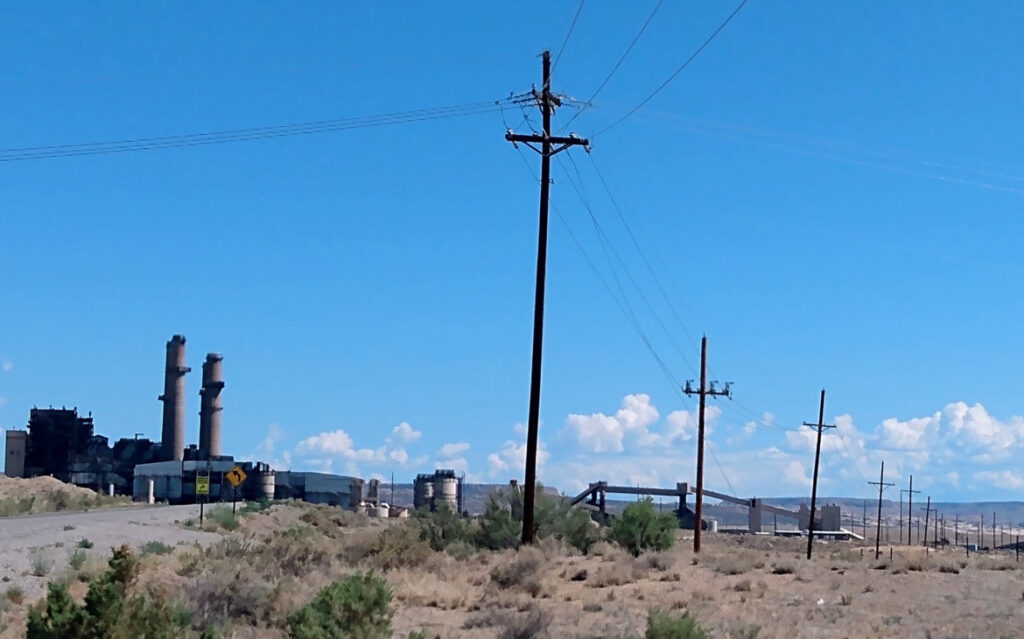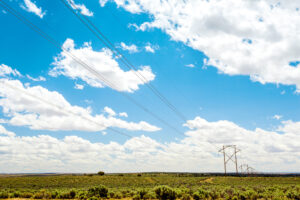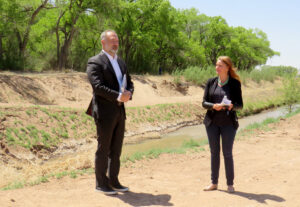Groups argue PNM will ‘overcharge’ customers by not issuing bonds when SJGS closes

Western Resource Advocates and Coalition for Clean Affordable Energy say Public Service Company of New Mexico (PNM) will “unlawfully over-charge its customers $125 million during the next two years.” These overcharges will come from what they describe as a delay in issuing bonds associated with the closure of the San Juan Generating Station in October of this year.
WRA and CCAE filed a joint motion with the New Mexico Public Regulation Commission requesting that the commission issue an order essentially requiring PNM to issue the securitized bonds that are intended to refinance the past investments into the San Juan Generating Station and save customers money. WRA and CCAE state in the filing that delaying issuing the bonds withholds a “roughly ten percent decrease in rates that customers are entitled to receive” when the power plant closes.
Following the joint motion, the PRC issued a single-signature order on March 4 requiring PNM to respond to the arguments and allowing the other intervenors in the case to reply to the utility’s response.
In those filings, several intervenors stated that PNM agreed to provide an immediate rate credit to customers upon the closure of the power plant. PNM argues that nothing in the Energy Transition Act or in the financing order that the PRC approved requires the utility to provide that credit.
PNM says it plans to time the issuance of the bonds with the conclusion of a rate case, which it plans to file in December. That could mean the bonds won’t be issued until 2024.
“PNM’s planned delay, however, would have the Company continue collecting San Juan costs in rates at its full cost of capital after the plant is abandoned, and then issue securitized bonds in its discretion at some future date,” WRA and CCAE stated in their joint motion. “By PNM’s logic, it could sit back for 30 years, taking no action to issue bonds and collecting a return both of and on its abandoned facility – to say nothing of the O&M and other costs reflected in rates. Then, 30 years later, after fully depreciating its stranded asset, issue its bonds and recover its stranded costs once again. This potential for double recovery of hundreds of millions of dollars demonstrates why PNM’s position is untenable.”
According to PNM, issuing the bonds when the new rates go into effect prevents a roller coaster effect where customers would see savings from the power plant closure followed by a rate increase to recover investments that PNM has made into the grid since 2018.
The last time PNM increased rates was in 2019 following the 2016 rate case.
Assistance for impacted workers, communities
WRA and CCAE also argue that delaying issuing the bonds will hurt workers and impacted communities who, under the Energy Transition Act, will receive financial support from the bonds. The ETA requires that a portion of the bond revenue be set aside for workforce and economic development as well as support for the Navajo Nation. This money is supposed to be distributed through the state Economic Development Department, Department of Workforce Solutions and Indian Affairs Department.
PNM says that the funding for the impacted workers and communities will be provided even if bonds are never issued.
PNM spokesman Ray Sandoval said the utility has pre-funded 25 percent of the money that is supposed to go to the three state agencies.
“In October, when the plant closes, PNM will fund the remaining, so that entire $40 million will completely be taken care of,” he said.
PNM says it has been transparent about plans
Sandoval cited testimony from the PRC hearings in 2019 about the financing when a hearing examiner asked Henry Monroy, PNM’s chief financial officer, about how the bonds will be issued. Sandoval said Monroy replied that the bonds would be issued with the rate case. At that time, Monroy told the hearing examiner that the utility would file one in 2020 and a second one in 2021. The 2021 rate case would be filed to take the San Juan Generating Station out of the customers’ rates and to apply the savings from the Energy Transition Act back to customers.
“Then the hearing examiner says, ‘is there going to be a bill decrease?’ And Henry says ‘no, because at this point, the amount of money that we’ve spent on new projects and investments are going to be more than what savings are for San Juan,’” Sandoval said.
The plans for the 2020 and 2021 rate cases were put on hold for two reasons, according to PNM. The first of those reasons is the COVID-19 pandemic. Sandoval said PNM did not want to hit customers with increased bills while they were experiencing financial hardship. The second reason was the proposed merger with the utility giant Avangrid, which the PRC ultimately rejected. PNM and Avangrid have appealed the PRC’s decision in that case. Sandoval said PNM made a commitment to Avangrid that it would not file the rate case until December of this year and, even though the PRC rejected the merger application, PNM is honoring that commitment.
Mariel Nanasi, executive director of New Energy Economy and a vocal critic of PNM, argued that PNM’s reasoning to delay the 2020 rate case was not about concern for customers. She said if PNM was concerned about the customers, it would not have taken steps to disconnect people for nonpayment as soon as a moratorium on disconnections was lifted.
While PNM says that it has been clear about its plans, a Thursday filing by the Office of the New Mexico Attorney General states that the office learned of the utility’s plans after reading the joint motion by WRA and CCAE.
“While state legislators are contemplating actions to help New Mexicans pay record high fuel prices amidst rates of inflation not seen in 40 years, PNM is seeking to deny its customers the rate decrease they are due once SJGS is abandoned. The Commission has the authority to order PNM’s compliance and it must exercise it now to prevent PNM from unjustly enriching its shareholders at the expense of its customers,” the attorney general’s office filing states.
Rates will increase despite power plant closure
While coal tends to be more expensive than renewable energy, in part because of ongoing fuel costs and coal’s labor-intensive nature, Sandoval said customers will see a rate increase proposed in the upcoming rate case.
However, customers will see some benefits from the closure of the San Juan Generating Station in January after the fuel clause resets, he said. This will result in customers saving $3 a month because PNM will not have to purchase coal to run the power plant.
Additionally, he said that the rate case will take into account the closure of the San Juan Generating Station.
“Anything that [customers] pay towards San Juan is going to be offset when we go back to our rate case, because we’re going to propose it that way,” he said.
The rate case will likely take 12 to 18 months to complete, Sandoval said.
Since 2018, PNM has invested $1.2 billion and the utility plans to invest another $1.2 billion by 2024. These investments will be included in the next rate case. According to PNM, the rates it will request in the next case will be 30 to 40 percent lower because of the closure of the San Juan Generating Station and the delay in issuance of the bonds.
The proposed increase will be caused by investments that PNM has to make to upgrade the grid. Sandoval said the way the grid was built the power flowed directly from power plants to urban centers using transmission lines, but the transition to renewable and clean energy sources requires new infrastructure investments, including new transmission lines.
“The revenues collected through rates that covered San Juan will offset the $2.4 billion in new investments in PNM’s infrastructure,” PNM said in an emailed statement to NM Political Report. “Those investments go toward service reliability for customers. There’s no ability to double dip by PNM because the rates are set by the PRC. PNM’s plan calls for an offset of the revenue generated from the San Juan plant after its closure and the regulatory process itself prevents any double dipping from occurring.”
This article was originally posted on Groups argue PNM will ‘overcharge’ customers by not issuing bonds when SJGS closes







